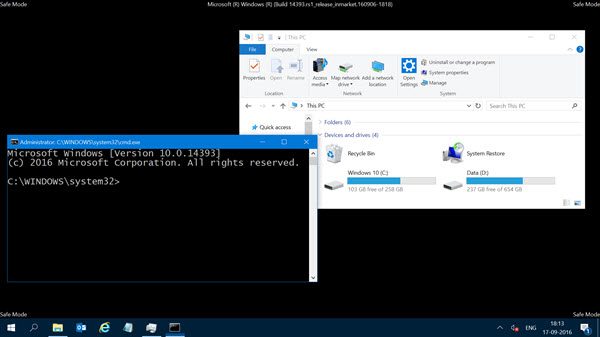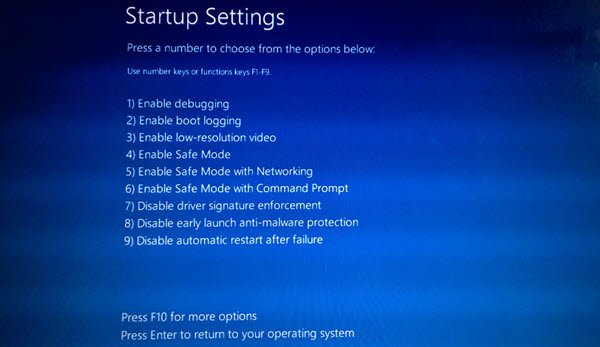In this post, we will see what is Safe Mode in Windows and what are the different types of Safe Mode – like Safe Mode, Safe Mode with Networking & Safe Mode with Command Prompt and what they mean.

Most Windows users may be familiar with the Safe Mode, as it is often required when you need to diagnose or troubleshoot Windows problems. We have already see how to start Windows in Safe Mode and how to directly reboot Windows in Safe Mode. Now let us take a look at what Safe Mode means and the types of safe Mode that Windows OS offers.
Safe Mode in Windows 11/10

Safe Mode is a diagnostic mode in Windows OS used to identify and troubleshoot software problems. It starts the computer with only the most basic drivers, features and services, allowing the user to troubleshoot issues. When you start Windows 11 or Windows 10 in Safe Mode, the operating system only loads those minimum set of Drivers, files, and applications that are required for it to load.
What are the different different types of Windows Safe Mode?
There are three different types of Safe Mode:
- Safe Mode
- Safe Mode with Networking
- Safe Mode with Command Prompt
Let us take a look at these three in detail.
Safe Mode
When you boot in Safe Mode – the very basic configuration is loaded. You boot into a black desktop, and you may find that your fonts and icons look big and are not sharp. This is because only the very basic drivers are loaded. You will have access to your Start Menu, as well as Mouse and Keyboard, and you will also be able to access your files. You will also see Safe Mode written on all four corners and your Windows version number in the top center. If you wish to use System Restore or run your antivirus scan to remove malware, which is often the case with most home users, this is the best mode to boot into. Apart from this function you also get access to other built-in Windows tools, like Command Prompt, PowerShell, Computer Manager, Device Manager, Event Log Viewer, etc.
Safe Mode with Networking
When you boot in Safe Mode with Networking, you are taken to your desktop. One extra set of drivers – and those are the networking drivers that get loaded. This allows you to connect the computer to your network or the Internet. It is recommended that one not surf the web in Safe Mode as your system is in a vulnerable and unprotected state.
Safe Mode with Command Prompt
When you boot into Safe Mode with Command Prompt, you do not boot in the Windows GUI. You are directly given access to an open Command Prompt window. Since you do not get access to your desktop and start menu, usually only experts who need to carry out some advanced troubleshooting use this mode.
Read: Windows crashes or freezes even in Safe Mode.
How turn Safe Mode off in Windows?
To turn Safe Mode off in Windows, click on the Start Menu to open it, click the Power icon and then select the Restart option. On restart, Windows will restart normally to your desktop.
TIP: You can add Safe Mode to Boot Menu options in Windows.
There are some other posts about Safe Mode on this website. Do take a look at them too.
- Safe Mode not working in Windows.
- Uninstall programs in Safe Mode in Windows
- How to Enable and Boot into Safe Mode on Windows
- How to boot in Safe mode while dual booting Windows
- Display Startup Settings & Boot into Safe Mode in Windows
- Make Windows Installer work in Safe Mode
- PC is stuck and cannot exit Safe Mode.
- Enable F8 key & Safe Mode in Windows
- Windows Safe Mode says Password is incorrect.
Hope this answers your questions about the Safe Mode in Windows OS.
Andy, after the Anniversary Update for Windows 10, a few days later, I started up my PC and was in Safe Mode! I didn’t make my PC go into Safe Mode, it was just there. I did all of the normal things, like checking Device Manager, the Registry and so forth. Nothing seemed out of order. I could not get out of Safe Mode. I had upgraded to Windows 10 Pro 64Bit, as a free upgrade. To get out of Safe Mode, I had to reinstall Windows 7 Pro 64Bit, since, none of my System Restores would work in Safe Mode.
So, here I sit using Windows 7 Pro 64Bit and I can not upgrade back to Windows 10 Pro 64Bit without making full payment for the Windows 10. Needless to say, I am not pleased and I miss Windows 10. Is there anyway I can get Windows 10 Pro 64Bit back??? My Windows 10 was activated, so Microsoft has that on record.
Please help me and others who may have had the same thing happen to them. Writing an article or telling where there is an article about retrieving Windows 10 (Home, Pro, Ultimate), after the free upgrade period has ended.
@Juan Figueroa – Thank you so much. I went to the website suggested by you, downloaded the Media Tool and was on my way to retrieving Windows 10. It is now installed with my activation code and all the rest of the good stuff. :O)
I very stupidly downloaded a driver upadate and now my new Dell laptop with Windows 10 will not let me even get to my desktop, let alone Start button. I’ve tried for days to get into Safe Mode and cannot get in. I am at the end of my wits. Please help. I think the video driver update was corrupted or something so it won’t let me view anything. Shouldn’t I be able to go to safe mode and restore and undo the driver update? but how to get to that if all I get is a blank screen. thanks so much